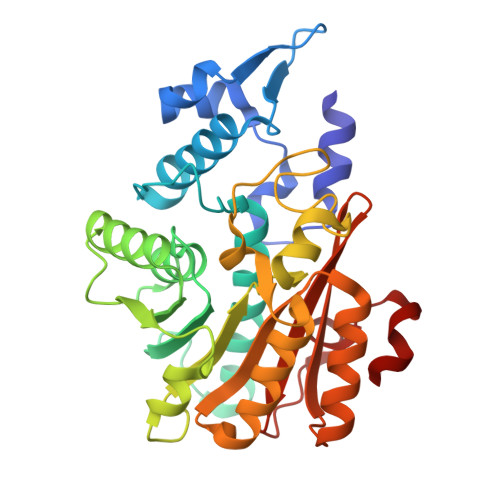The Second Methylation in Psilocybin Biosynthesis Is Enabled by a Hydrogen Bonding Network Extending into the Secondary Sphere Surrounding the Methyltransferase Active Site.
Hudspeth, J., Rogge, K., Wagner, T., Mull, M., Hoffmeister, D., Rupp, B., Werten, S.(2024) Chembiochem 25: e202400497-e202400497
- PubMed: 39413044
- DOI: https://doi.org/10.1002/cbic.202400497
- Primary Citation of Related Structures:
9FMH, 9FMI, 9FMJ, 9FMK - PubMed Abstract:
The Psilocybe cubensis SAM-dependent methyltransferase, PsiM, catalyzes the last step in the biosynthesis of psilocybin. Likely evolved from monomethylating RNA methyltransferases, PsiM acquired a key amino acid exchange in the secondary sphere of the active site, M247N, which is responsible for its capacity to dimethylate. Two variants, PsiMN247M and PsiMN247A, were generated to further examine the role of Asn247 for mono- and dimethylation in PsiM. Herein, we present the kinetic profiles of both variants and crystal structures at resolutions between 0.9 and 1.0 ?. Each variant was crystallized as a ternary complex with the non-methylated acceptor substrate, norbaeocystin and S-adenosyl-l-homocysteine, and in a second complex with the cofactor analog, sinefungin, and the monomethylated substrate, baeocystin. Consistent with the inability of the variants to catalyze a second methyl transfer, these structures reveal catalytically non-productive conformations and a high level of disorder of the methylamine group of baeocystin. Additionally, both variants exhibit destabilization in the ¦Â5-¦Â7 sheets and a conserved ¦Â-turn of the core Rossmann fold, causing 20-fold reduced substrate binding and 2-fold lower catalytic efficiency even with norbaeocystin.
Organizational Affiliation:
Colorado School of Mines, Department of Chemistry, UNITED STATES MINOR OUTLYING ISLANDS.



















